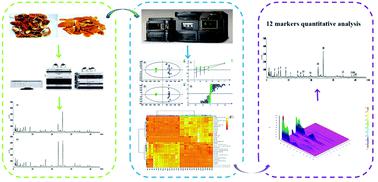当前位置:
X-MOL 学术
›
Food Funct.
›
论文详情
Our official English website, www.x-mol.net, welcomes your
feedback! (Note: you will need to create a separate account there.)
A rapid protocol to distinguish between Citri Exocarpium Rubrum and Citri Reticulatae Pericarpium based on the characteristic fingerprint and UHPLC-Q-TOF MS methods.
Food & Function ( IF 5.1 ) Pub Date : 2020-04-08 , DOI: 10.1039/d0fo00082e Liqiang Shi 1 , Rongjin Wang 1 , Tianshu Liu 1 , Jiajie Wu 1 , Hongxu Zhang 1 , Zhiqiang Liu 2 , Shu Liu 2 , Zhongying Liu 1
Food & Function ( IF 5.1 ) Pub Date : 2020-04-08 , DOI: 10.1039/d0fo00082e Liqiang Shi 1 , Rongjin Wang 1 , Tianshu Liu 1 , Jiajie Wu 1 , Hongxu Zhang 1 , Zhiqiang Liu 2 , Shu Liu 2 , Zhongying Liu 1
Affiliation

|
Citri Exocarpium Rubrum (CER) and Citri Reticulatae Pericarpium (CRP) are used as common functional foods and traditional Chinese medicine (TCM). As different parts of the same fruit, CER and CRP have different effects in clinical applications. However, they are commonly confused due to the similarity of the chemical compounds and a lack of scientific method to distinguish them in the finished product. In this study, an ultra-high performance liquid chromatography-diode array detector (UHPLC-DAD) technique and an ultra-high performance liquid chromatography-quadrupole time-of-flight mass spectrometry (UHPLC-Q-TOF MS) method were employed to generate the characteristic fingerprint under the optimum analytical conditions. Principal component analysis (PCA) and orthogonal partial least squares discrimination analysis (OPLS-DA) were applied to represent different chemical markers for CER and CRP. 44 potential markers including 15 polymethoxylated flavanones (PMFs), 5 flavone-C-glycosides, 6 flavanone-O-glycosides, 3 flavonoid-O-glycosides, 8 organic acids, 5 limonoids and 2 alkaloids were successfully identified by using UNIFI software. The heat map showed that there were significant differences in the CER and CRP samples. Furthermore, 12 potential markers were screened out by characteristic fingerprint and UHPLC-Q-TOF MS methods and were analyzed by quantitative analysis of multicomponents by a single marker (QAMS) method. Finally, a prediction model based on the discovered chemical markers was established for discrimination between CER and CRP. Using these markers can significantly distinguish the unknown processed products of CER and CRP. In conclusion, an effective way to quickly and easily distinguish CER and CRP was successfully established based on the characteristic fingerprint and UHPLC-Q-TOF MS. It could also be a new strategy for analysis of different processed products of the same plant source.
中文翻译:

基于特征指纹图谱和UHPLC-Q-TOF MS方法的快速区分红皮柠檬皮和网皮皮皮的协议。
柠檬皮外皮(CER)和网纹皮外皮(CRP)被用作常见功能性食品和中药(TCM)。作为同一果实的不同部分,CER和CRP在临床应用中具有不同的作用。但是,由于化合物的相似性以及缺乏在成品中区分它们的科学方法,它们通常会造成混淆。本研究采用超高效液相色谱-二极管阵列检测器(UHPLC-DAD)技术和超高效液相色谱-四极杆飞行时间质谱(UHPLC-Q-TOF MS)方法在最佳分析条件下生成特征指纹。应用主成分分析(PCA)和正交偏最小二乘判别分析(OPLS-DA)来代表CER和CRP的不同化学标记。使用UNIFI软件成功鉴定出44种潜在标记,包括15种聚甲氧基黄烷酮(PMF),5种黄酮C糖苷,6种黄酮O糖苷,3种黄酮O糖苷,8种有机酸,5种柠檬苦素和2种生物碱。热图表明,CER和CRP样品之间存在显着差异。此外,通过特征性指纹图谱和UHPLC-Q-TOF MS方法筛选出12种潜在标记,并通过单标记(QAMS)方法对多组分进行定量分析。最后,建立了基于发现的化学标记的预测模型,用于区分CER和CRP。使用这些标记可以显着区分CER和CRP的未知加工产品。综上所述,基于特征指纹图谱和UHPLC-Q-TOF MS,成功建立了快速简便地区分CER和CRP的有效方法。它也可能是分析同一植物来源的不同加工产品的新策略。
更新日期:2020-04-08
中文翻译:

基于特征指纹图谱和UHPLC-Q-TOF MS方法的快速区分红皮柠檬皮和网皮皮皮的协议。
柠檬皮外皮(CER)和网纹皮外皮(CRP)被用作常见功能性食品和中药(TCM)。作为同一果实的不同部分,CER和CRP在临床应用中具有不同的作用。但是,由于化合物的相似性以及缺乏在成品中区分它们的科学方法,它们通常会造成混淆。本研究采用超高效液相色谱-二极管阵列检测器(UHPLC-DAD)技术和超高效液相色谱-四极杆飞行时间质谱(UHPLC-Q-TOF MS)方法在最佳分析条件下生成特征指纹。应用主成分分析(PCA)和正交偏最小二乘判别分析(OPLS-DA)来代表CER和CRP的不同化学标记。使用UNIFI软件成功鉴定出44种潜在标记,包括15种聚甲氧基黄烷酮(PMF),5种黄酮C糖苷,6种黄酮O糖苷,3种黄酮O糖苷,8种有机酸,5种柠檬苦素和2种生物碱。热图表明,CER和CRP样品之间存在显着差异。此外,通过特征性指纹图谱和UHPLC-Q-TOF MS方法筛选出12种潜在标记,并通过单标记(QAMS)方法对多组分进行定量分析。最后,建立了基于发现的化学标记的预测模型,用于区分CER和CRP。使用这些标记可以显着区分CER和CRP的未知加工产品。综上所述,基于特征指纹图谱和UHPLC-Q-TOF MS,成功建立了快速简便地区分CER和CRP的有效方法。它也可能是分析同一植物来源的不同加工产品的新策略。











































 京公网安备 11010802027423号
京公网安备 11010802027423号